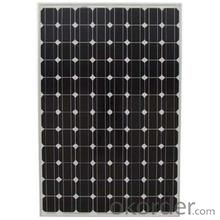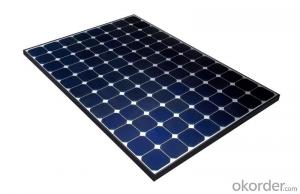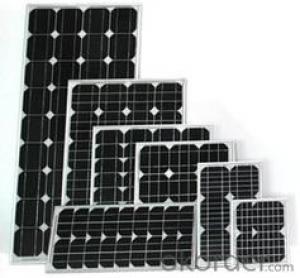CNBM On Grid System 4000W with Certificate UL TUV CE
- Loading Port:
- Shanghai
- Payment Terms:
- TT OR LC
- Min Order Qty:
- 100 watt
- Supply Capability:
- 1000 watt/month
OKorder Service Pledge
OKorder Financial Service
You Might Also Like
Item specifice
CNBM On Grid System 4000W with Certificate UL TUV CE
Product description
Connection of the photovoltaic power system can be done only through an interconnection agreement between the consumer and the utility company. The agreement details the various safety standards to be followed during the connection.[4]
Systems such as Net Metering and Feed-in Tariff which are offered by some system operators, can offset a customers electricity usage costs. In some locations though, grid technologies cannot cope with distributed generation feeding into the grid, so the export of surplus electricity is not possible and that surplus is earthed.
Grid-connected PV systems are comparatively easier to install as they do not require a battery system.[1][6]
Grid interconnection of photovoltaic (PV) power generation systems has the advantage of effective utilization of generated power because there are no storage losses involved.[7]

Application
Industrial
Commercial
Residential
Feature
Residential, grid-connected rooftop systems which have a capacity more than 10 kilowatts can meet the load of most consumers.[2] They can feed excess power to the grid where it is consumed by other users. The feedback is done through a meter to monitor power transferred. Photovoltaic wattage may be less than average consumption, in which case the consumer will continue to purchase grid energy, but a lesser amount than previously. If photovoltaic wattage substantially exceeds average consumption, the energy produced by the panels will be much in excess of the demand. In this case, the excess power can yield revenue by selling it to the grid. Depending on their agreement with their local grid energy company, the consumer only needs to pay the cost of electricity consumed less the value of electricity generated. This will be a negative number if more electricity is generated than consumed.[3] Additionally, in some cases, cash incentives are paid from the grid operator to the consumer.
Packaging
With carton and box
- Q:What is the impact of bird droppings on the performance of solar panels?
- Bird droppings can have a negative impact on the performance of solar panels. When bird droppings accumulate on the surface of the panels, they can create a film that reduces the amount of sunlight reaching the photovoltaic cells. This can lead to a decrease in the overall energy production of the panels. Additionally, bird droppings can also cause shading and create hotspots on the panels, further affecting their efficiency. Regular cleaning and maintenance of solar panels are necessary to minimize the impact of bird droppings and ensure optimal performance.
- Q:Can solar energy systems be used in multi-story buildings?
- Yes, solar energy systems can certainly be used in multi-story buildings. They can be installed on rooftops, terraces, or other available open spaces to harness sunlight and generate electricity. In fact, multi-story buildings often have larger roof areas, which can accommodate a greater number of solar panels, allowing for more efficient energy production. Additionally, advancements in solar technology, such as the use of thin-film solar panels, have made it easier to integrate solar systems into the facade and windows of multi-story buildings, further expanding their potential use in these structures.
- Q:How does the cost of solar panels vary based on the manufacturer?
- The cost of solar panels can vary based on the manufacturer due to several factors. Different manufacturers may use different technologies, materials, and production methods, which can affect the overall cost of the panels. Additionally, brand reputation and market demand can also influence the pricing. Some manufacturers may offer premium panels with higher efficiency and durability, resulting in a higher cost, while others may focus on providing more affordable options. Ultimately, it is important to consider factors like quality, warranty, and long-term performance when comparing prices from different manufacturers.
- Q:How do solar energy systems handle power outages?
- Solar energy systems do not provide power during a power outage. However, systems that are connected to the grid can have battery storage or backup generators to provide electricity during such situations. Standalone solar systems with battery storage can also provide limited power during an outage, depending on the capacity of the batteries.
- Q:Are there any environmental benefits to using solar energy systems?
- Yes, there are several environmental benefits to using solar energy systems. Firstly, solar energy is a clean and renewable source of power, which means it does not release harmful pollutants or greenhouse gases into the atmosphere, unlike fossil fuels. By reducing our reliance on coal, oil, and natural gas, solar energy helps to mitigate climate change and improve air quality. Additionally, solar panels do not require water for operation, unlike traditional power plants, conserving this precious resource. Overall, solar energy systems offer a sustainable and environmentally friendly solution to meeting our energy needs.
- Q:What is the role of solar water pumps in solar energy systems?
- The role of solar water pumps in solar energy systems is to harness the power of the sun to pump water, eliminating the need for traditional electricity sources. These pumps are essential in providing clean and sustainable water supply for agricultural irrigation, livestock watering, and domestic use in areas with limited access to electricity or unreliable grid power. By utilizing solar energy, these pumps contribute to reducing carbon emissions and promoting renewable energy adoption.
- Q:Can solar energy systems be used for powering off-grid telecommunications networks?
- Yes, solar energy systems can be used effectively for powering off-grid telecommunications networks. Solar panels can generate electricity from sunlight, which can then be stored in batteries for use during periods of low or no sunlight. This renewable energy source provides a reliable and sustainable power solution for off-grid telecommunications networks, ensuring continuous operation even in remote locations without access to traditional power grids. Additionally, solar energy systems are cost-effective and environmentally friendly, making them a preferred choice for powering off-grid telecommunications networks.
- Q:Can a solar energy system be installed in areas prone to hailstorms?
- Yes, solar energy systems can be installed in areas prone to hailstorms. However, it is essential to consider certain factors to ensure their durability and resilience against hail damage. This includes using high-quality materials, such as tempered glass for solar panels, and proper installation techniques. Additionally, some solar panels are specifically designed to withstand hail and extreme weather conditions, providing further protection.
- Q:Can solar energy systems be used for powering electric vehicle solar charging roads?
- Yes, solar energy systems can be used to power electric vehicle solar charging roads. Solar panels can be installed alongside or on top of the roads, converting sunlight into electricity. This electricity can then be used to power electric vehicle charging stations located along the roads, allowing vehicles to charge their batteries while driving. This innovative technology can help reduce dependence on fossil fuels and promote sustainable transportation options.
- Q:Can solar energy systems be used for indoor lighting?
- Yes, solar energy systems can be used for indoor lighting. Solar panels can generate electricity from sunlight, which can be stored in batteries and used to power indoor lights. This provides a sustainable and renewable source of energy for indoor lighting, reducing reliance on traditional electricity grids.
1. Manufacturer Overview |
|
|---|---|
| Location | |
| Year Established | |
| Annual Output Value | |
| Main Markets | |
| Company Certifications | |
2. Manufacturer Certificates |
|
|---|---|
| a) Certification Name | |
| Range | |
| Reference | |
| Validity Period | |
3. Manufacturer Capability |
|
|---|---|
| a)Trade Capacity | |
| Nearest Port | |
| Export Percentage | |
| No.of Employees in Trade Department | |
| Language Spoken: | |
| b)Factory Information | |
| Factory Size: | |
| No. of Production Lines | |
| Contract Manufacturing | |
| Product Price Range | |
Send your message to us
CNBM On Grid System 4000W with Certificate UL TUV CE
- Loading Port:
- Shanghai
- Payment Terms:
- TT OR LC
- Min Order Qty:
- 100 watt
- Supply Capability:
- 1000 watt/month
OKorder Service Pledge
OKorder Financial Service
Similar products
New products
Hot products
Related keywords





























